The Runaway Review
Join Product Manager, JJ Hocken, as he reviews batteries and discusses the advantages and disadvantages of various chemistries impacting the UPS industry.
The Runaway Review
Join Product Manager, JJ Hocken, as he reviews batteries and discusses the advantages and disadvantages of various chemistries impacting the UPS industry.
AI's Influence on UPS Battery Technology
APRIL 22,2024
 |
by J.J. Hocken, Product Manager Batteries & DC Technologies |
The Future of Power Density
AI requires tremendous amounts of power, and those loads can peak frequently and erratically, creating step loads that can be very problematic for some UPS module systems.
Many power system designers and data center operators are asking: Are AI loads mission critical loads?
The answer is not so straightforward and is dependent on what the client is using AI to perform.
As AI is utilized more frequently in our daily lives, the applications that the AI power loads are performing may become more critical in nature. Read more about AI's impact on data centers.
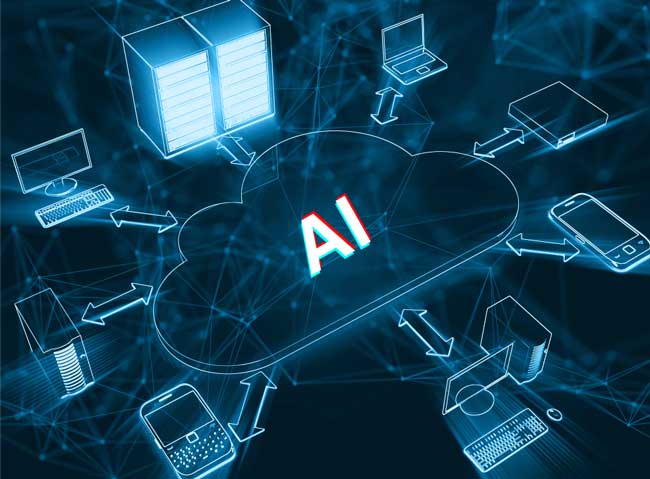
Sizing the UPS battery to accommodate the new load demands will become increasingly more challenging. Luckily, many battery vendors in the UPS industry are developing batteries to meet the growing demand for more power dense battery systems.
In UPS mission critical applications, future battery racks will have 35%-75% more power per rack. However, the increase in power density for larger UPS systems will create unprecedented challenges.
The Industry's Path Ahead
- A 35-75%+ increase in power per battery rack
- Possible changes in fire safety regulations to meet the growing power boom
- UL9540 Edition 3 (June 2023)
- UL1973 Edition 3 (February 2022)
- NFPA 855 (2023 Edition)
- International Fire Code (2024)
- Increased arc-flash concerns and increased DC ratings = heightened safety concerns
- Innovations in design of lithium-ion battery solutions for LFP, NMC, and LMO chemistries.
- Adoption of alternative chemistry batteries and DC technologies, such as:
- Nickel Zinc
- Sodium-Ion
- Iron Flow Batteries
- Lithium-Ion Capacitors
- Solid State Batteries
(AI is paving the way in assisting to find, develop, and choose alternative battery materials to design Solid State Batteries)
The Future Utilization of Power Dense Batteries
The new challenge posed by AI load power demands can be tackled in different ways.
The traditional way is to utilize a UPS with high frequency sampling to detect changes in current and deviations in voltage and verify the size of the UPS and battery system for the increased peak loads.
In this use case, the battery is sized to manage the entire load, similar to a traditional mission critical application.
There are alternative methods that utilize low voltage peak shaving or load shifting applications using high cycle rate batteries with increased power density.
In this alternative hypothetical use case, the battery cycles during peak loads to supplement the utility.
There are two different batteries that approach this scenario differently based on their design attributes.
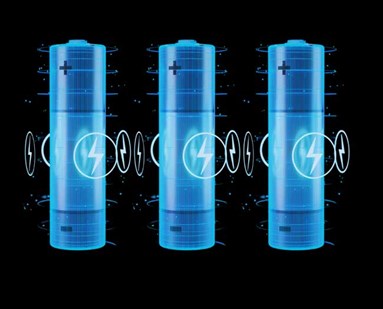
High-Energy Capacity Battery/DC Technology
The first type of battery or DC technology is characterized as having:
- Medium power
- High-energy capacity
- Low charge rate
- High cycle rate
The use case is similar to energy storage applications but for shorter durations like a 1-hour micro-grid application.
This type of battery can be large and expensive. The battery would utilize a set throughput and cycle repeatedly and charge when possible. This would occur very similar to a load shifting application as shown below.
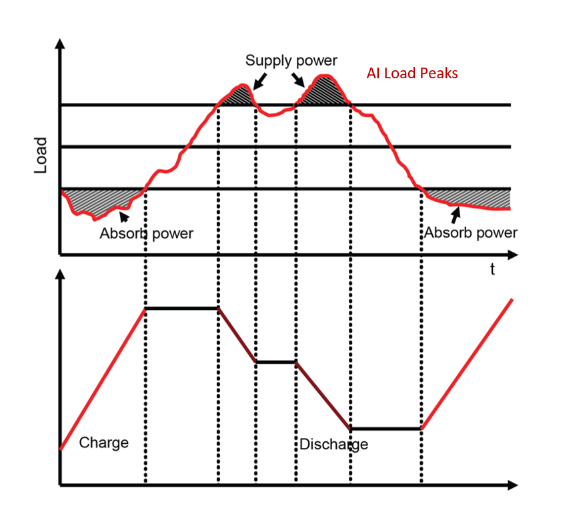
Low-Energy Capacity Battery/DC Technology
The second type of battery or DC technology is characterized as having:
- High power
- Low-energy capacity
- Very high charge rate
- High cycle rate
This use case of this battery is for high power, fast charging, quick discharge, repetitive applications. This battery may be more practical given fire safety regulations and commercial considerations due to the overall size and lower kWh capacity.
Batteries with high power densities, low-to-mid energy capacity, and high cycle rate capabilities would be ideal for this scenario.
In this scenario, the battery would immediately recharge, then discharge, then repeat and catch the peak loads by cycling the battery. The use case would be very similar to a peak shaving application but at higher cycle rates than a typical battery energy storage system.
This application requires a battery or DC technology that can discharge and charge fast and hold considerable power.
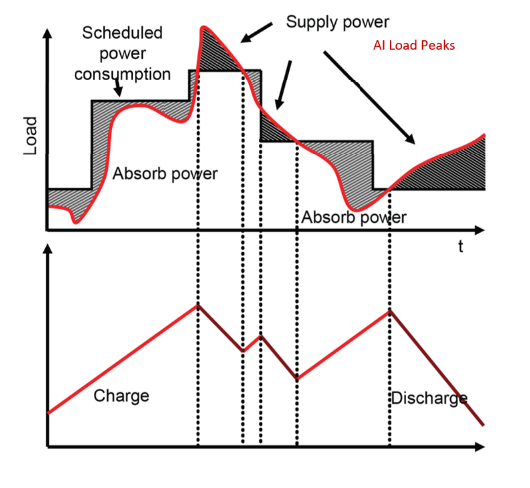
Increased Power Requires Greater Resonsibility
Understanding your battery system cycle rates, power ratings, energy capacity, and use case capabilities is vital to the success of your power system.
Clients of colocations or data centers may not inform operators and designers of their AI power loads until it is too late. This makes the responsibility of choosing the most reliable UPS even more vital to maintaining uptime.
Ideally, a UPS system for AI loads will have the highest reliability rating in the industry and high frequency sampling rates to meet your AI load demands.
Furthermore, a battery backup system that helps support these demands can only strengthen a colocation or data center’s protection. At Mitsubishi Electric, we are known for our extensive battery testing and our focus on safety and reliability throughout our backup system.
The future market for batteries and DC technologies is exciting and rapidly advancing. Mitsubishi Electric is working with various state of the art battery and DC technology vendors to investigate meeting current and future AI load requirements.
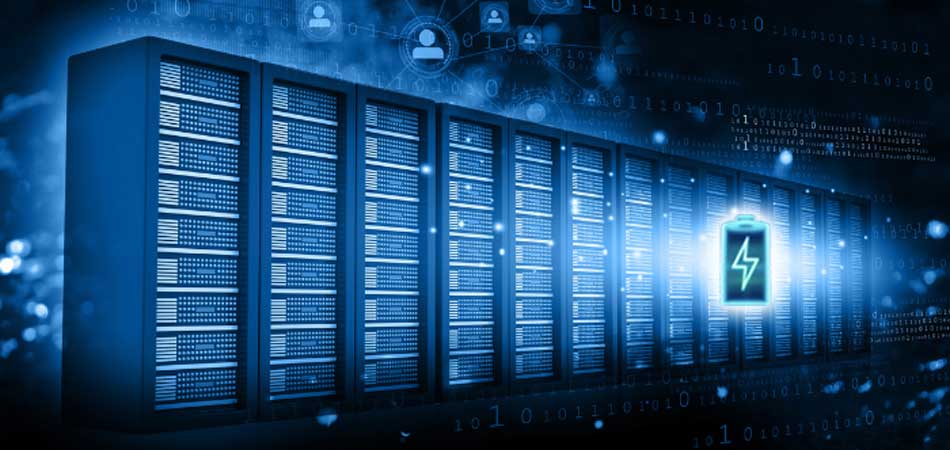
Edited by Nicole Kristof, Digital Marketing Specialist
Stay up-to-date on industry trends & insights
Be the first notified of new blog posts
By submitting this contact form, you agree that a representative(s) of Mitsubishi Electric Power Products, Inc. (MEPPI) may contact you using the information you provided. In accordance with our Privacy Policy, we will never share or sell your personal data.